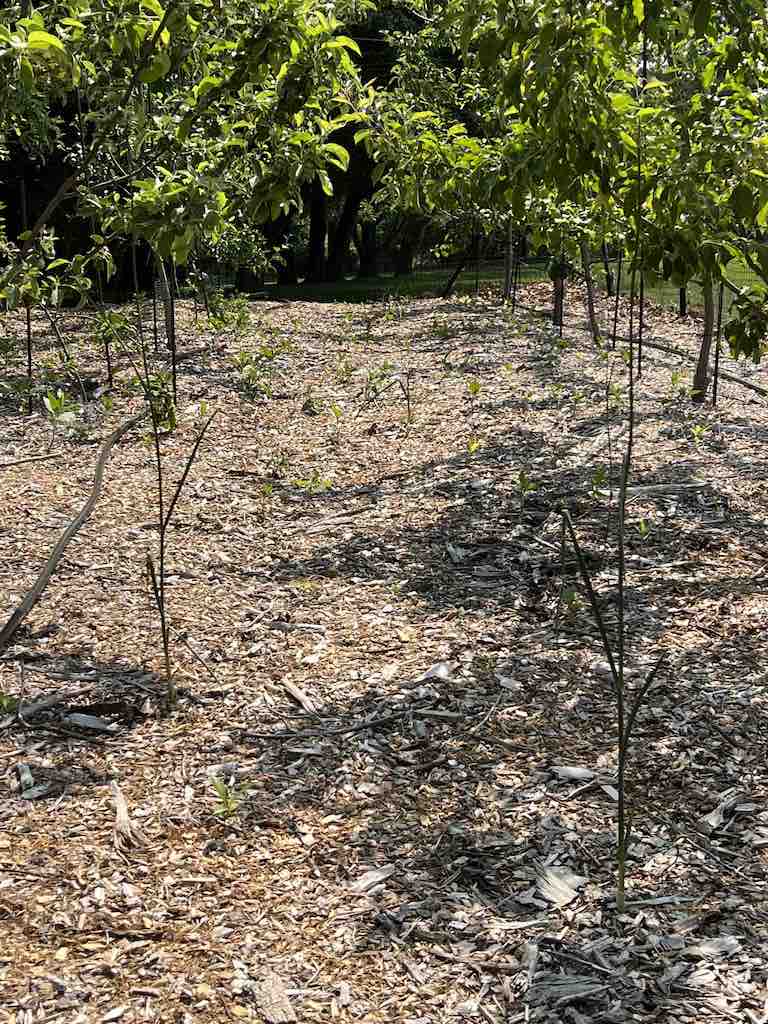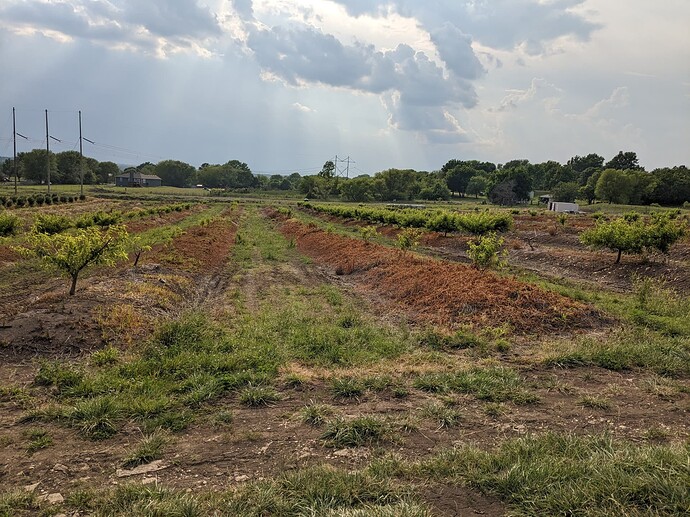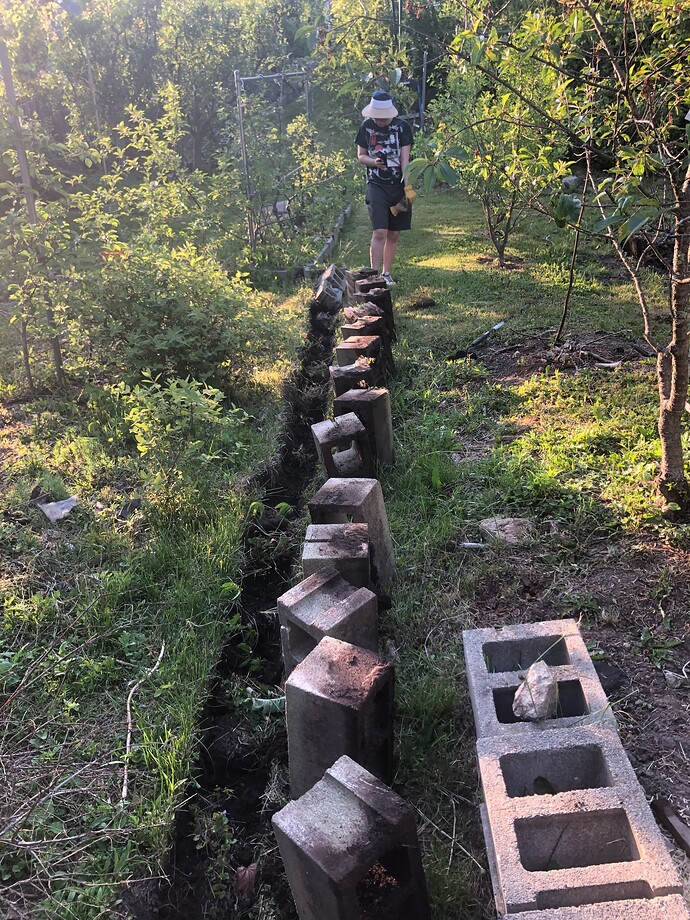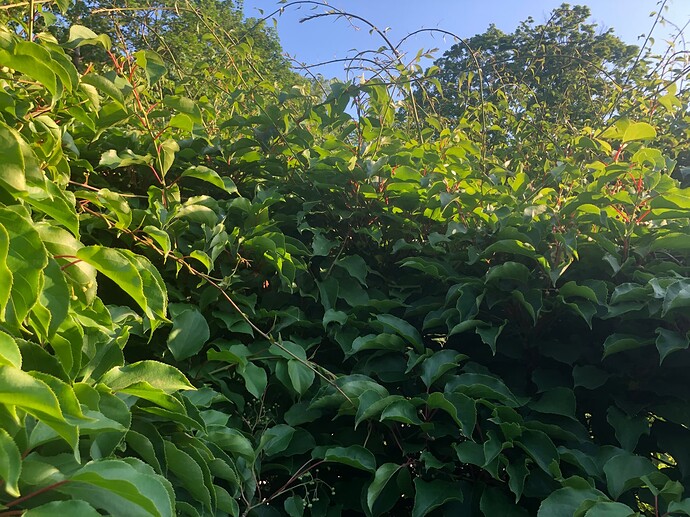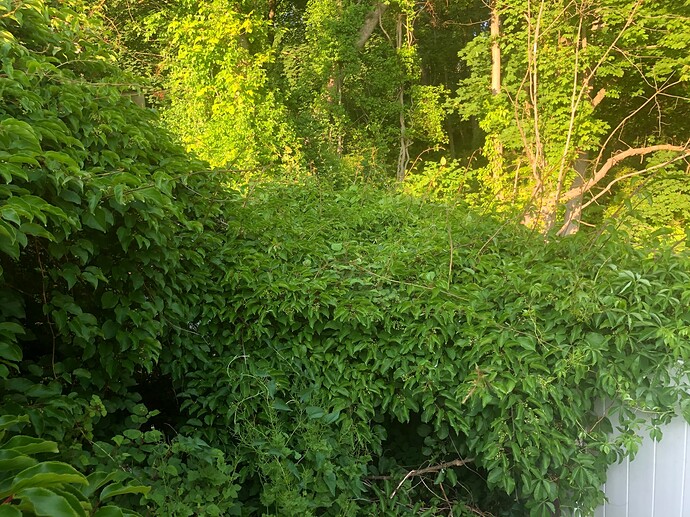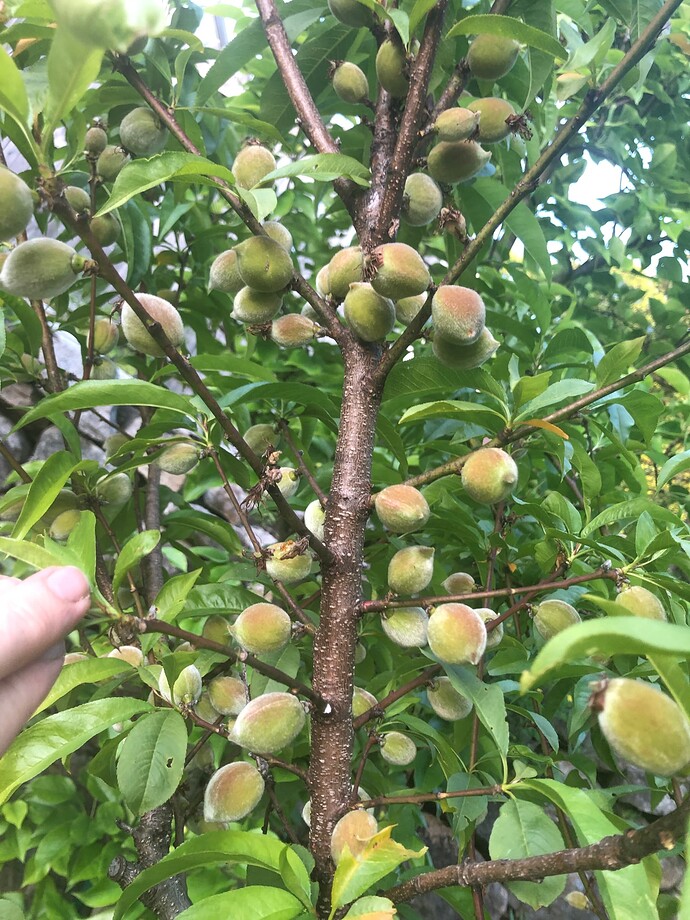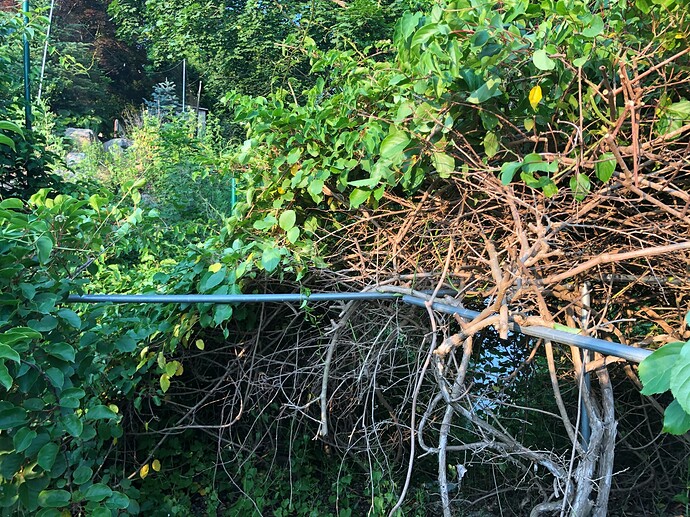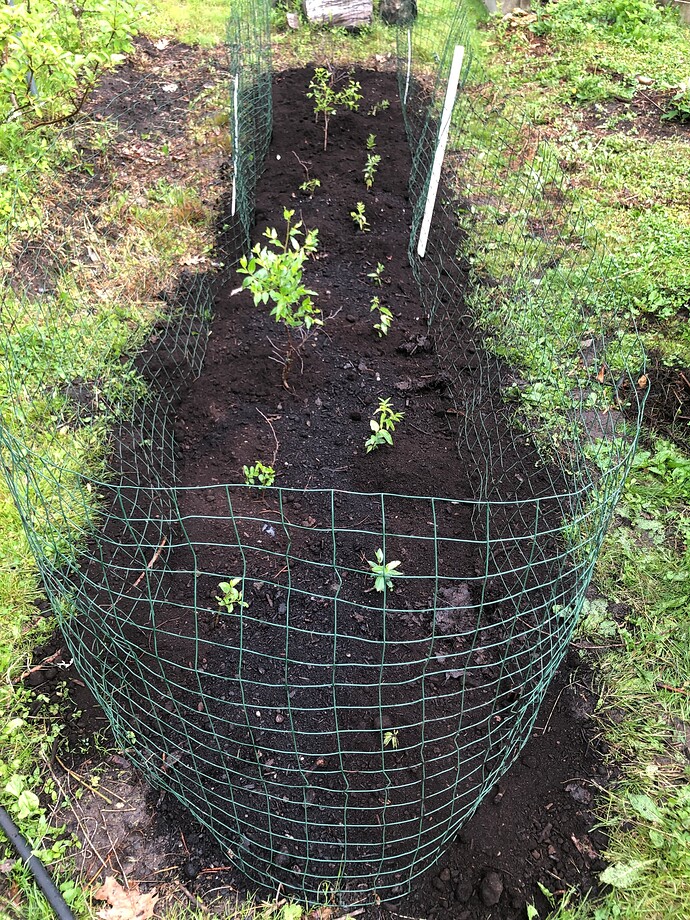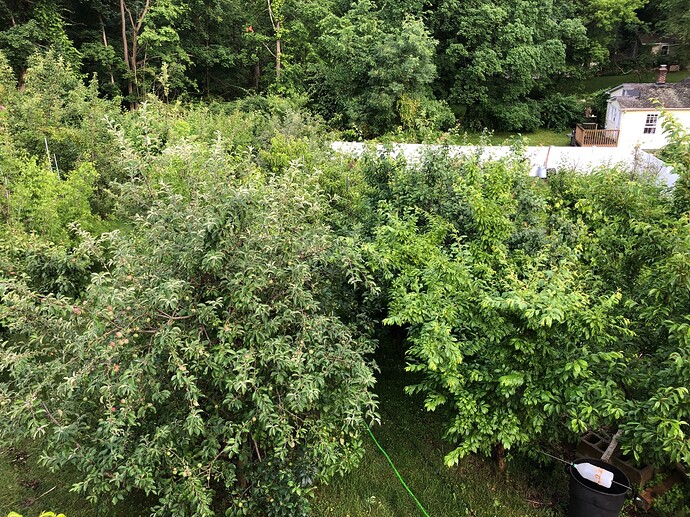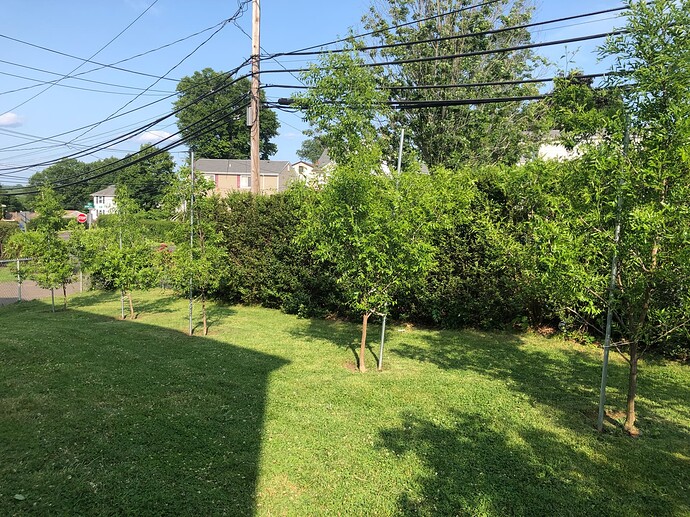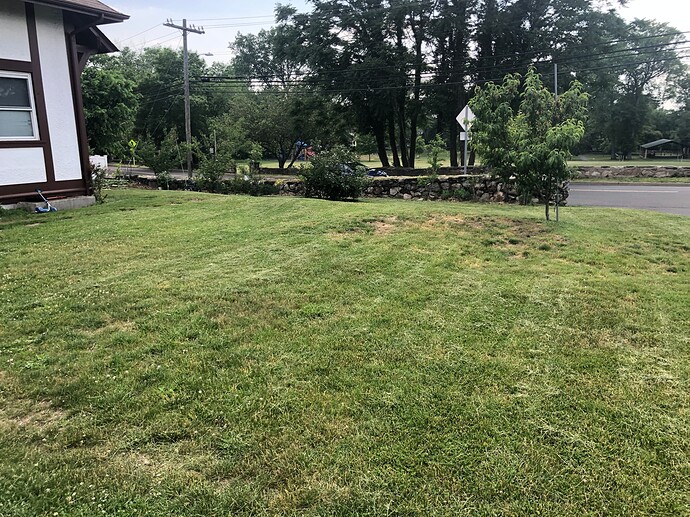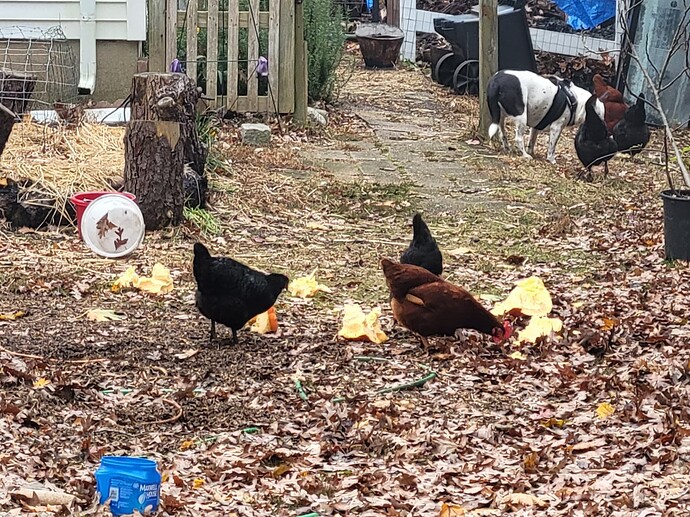If its Canadian thistle, mulch won’t do it.
I did exactly that to another separate planting of 24 dwarf apples on 8’ centers, three rows of eight. I didn’t measure exactly but it was probably 6-8” of wood chips. They compact and decay, so it was roughly 4-6” one year and 3-4” the next. I made sure to not pile up mulch against the trunks.
This worked well on most weeds. Grasses were demolished. But there are some perennial weeds that are strong enough to break through any mulch. Some examples — bindweed, horse nettle, burdock, dandelion’ wild onion. . . . These you’ll have to attack either by spot application if herbicide or by manual pulling. I didn’t want to risk damaging the trees so I went manual. The dwarf orchard now needs only a light once-over a few times a year.
One weed I’m finding often is oak trees. Clearly there were some acorns among the chips. ![]()
Cardboard helps. It probably stifles most of those perennials. I used it in part but didn’t have enough to cover the whole area…
That’s great news, if it keeps 95% of the grass/weeds down I’m game to try it! I’ll ask my arborist buddy for some chips. How picky should I be with the species of chips?
One thing about whackers is that most aren’t powerful enough to efficiently chop out thick weeds. I use Stihl’s most powerful one for the task and the last one I bought cost close to $600. A while back I bought a somewhat less expensive Stihl 4-stroke whacker and it was almost worthless for the tough job on my property that is something like what your photos showed. You need to use thick string too.
No wonder you so much prefer lawn mowers, you are underpowered. Small whackers are only good for edging grass and other light jobs. However having a cutter on wheels like a lawn mower, with 3 or 4 HP is great where there aren’t too many rocks or other obstacles.
People say that walnut is an issue but I don’t know whether that applies only to living trees, which produce herbicide-type chemicals in its roots.
I didn’t specify. I know based on where the cutting was being done that it was pretty much all healthy trees – oak, maple, hickory, locust, with some white pine and cedar.
You should specify a low percentage of leaves and sticks. Some is inevitable if trees are cut now, but the bigger the tree, the better. Chips from brush is a bad idea – very green and probably full of weeds.
Also, as mentioned elsewhere, you should avoid trees that have died due to some nasty infection, especially honey mushroom.
Ok thanks for the tips, that all makes sense.
For reference, this is what the floor of the dwarf orchard looks like. You can see that it’s pretty clean. If you look carefully you will notice some horse nettle, wild onion, and tiny tree seedlings – probably wild cherry, which is common here. Maybe oak too because there’s an oak tree on the east side.
I haven’t weeded here at all yet. It needs a quick pass soon but obviously not difficult. The horse nettle roots go deep so it’s very hard to eliminate them. You have to be persistent.
Here’s the bigger orchard. What you see is a lot of potted figs but there’re semi-dwarf apples plus some pears and persimmons.
I did weed most of this yesterday. There’s still some wild blackberry and bindweed.
Looks like a lovely place. Nice looking orchard.
When the kids grow up we are getting out of the city to find some land… I am jealous of all that space.
Weed control is probably the third highest labor input in our orchard (behind pruning and picking).
Here is a pic from yesterday where it shows the herbicide strips beside the new trees (the row middles need mowed).
Here is the tomatoes we mulched with hay. Already horse nettle is pushing up through the hay in places. Horse nettle and bindweed are the hardest weeds to kill in the orchard. No herbicide which can be used around trees will kill them.
The bulk of our time for the last month has been weed control in blackberries, tomatoes, under trees, mowing, and some hand weeding.
Is that orange mulch or dead weeds around the new trees in the first pic? Do you eventually mulch the trees? Also how tall are they? It’s hard to get a sense of scale…
Just dead weeds. The taller trees are only about 4’ tall.
I like it, want to keep mine that small in my backyard.
The trees actually get much bigger as they get older. I think it might be tough to keep peach trees that small, unless they were on some dwarf rootstock. The largest trees on the right (top picture) were planted in 2021.
I would have thought thinning would be a big task now. But, thinking about it, I have more mowing/weed control than I do thinning, even at this time of year.
Over the last few days, I’ve been working with my oldest to remove several “raised beds”, though they barely merit the name.
The “bed” in the above pic used to be a 20x30’ garden which was all raised up a bit. Now, it is mostly various trees and bushes, though I did re-purpose part of it for potatoes this year. But, when I made the space between the long low bed and the taller one on the right, there was just enough space for my mower. Over the years, I got a different mower and the blocks shifted a bit, so I couldn’t mow in between. Now, I’ve just removed the long low bed and smoothed the edge so I can mow the whole thing. I did bury some rocks in the strip where the blocks were to act as fill and help with the transition.
This is what a block bed (2 blocks high) looks like without the blocks. It used to have 3 figs in it, but only one of them ever produced- RDB and it wasn’t that productive. I moved (parts of) the RDB into a few in-ground spots and am planning to pot up a few sections of the other two figs roots to see if they do better in a pot.
I’m left with a lot of material that I have no idea what to do with. The wood is pretty rotten and will eventually get into the compost pile. Those rocks were not easy to move. We gave up on using the wheel barrow for the big ones- a hand cart worked much better.
I should have added a rule- to keep maintenance low, don’t grow hardy kiwi.
They can get out of control quickly. Even on my better constructed trellis (22x11 feet made from chain link posts and top rails), it is hard to keep them in check. And once they get away from you, it is hard to get things back under control.
I tried to take a panoramic pic while standing in the middle of the trellis, but it didn’t come out that well due to the sun. Basically, picture this view in all directions…
I’ve been letting the male vine go for a bit in the direction away from the trellis toward the corner of the yard, as I figured I wouldn’t need to pick anything. The trellis is on the left, with the fence (down hill, 10-15 feet away) on the right. At least there are a lot of flowers…
A pic from underneath the trellis. There are spots I can get to a pop my head through, but it isn’t as easy as it used to be… I think the plan now is to let everything flower, then cut the male vine back hard on the trellis side. I may need to bring out the hedge trimmers like Scott has been using on his kiwi.
Great pics Bob.
We got hit really hard with a frost, so very little thinning this year. But you’re right. Thinning is another big task.
Pluots and apricots got thinned here though not entirely. Two Sugar Pearls apricots (in different towns) are the only ones with a full-ish crop. Peaches are pretty full at my location, but from what I’ve heard most of the inland orchards in CT lost their entire crop due to the cold back in Feb. I don’t think it even got that cold, but it was a bit sudden. My low for the winter was around 0F. Most of my Asian persimmons are OK, though a young one had a lot of dieback.
For large-scale pruning the hedge trimmers wouldn’t have been enough. I used the loppers.
I was pruning for almost an hour and all I did was cut the male back a lot, as well as cutting as many of the vigorous suckers as I could reach from the females.
Here’s the male afterward. Don’t feel bad for him- there is a massive amount of growth upwards and where the vine grew away from the trelis, toward the corner of the yard. I’ve dubbed it the Kiwi Bermuda Triangle, as you could easily get lost and drowned in vines there.
I ended up planting 20 jujube seedlings there. Hopefully they can size up enough that I’ll be able to take scionwood from them (even if it means cutting them off at ground level to do so…) and graft them to mature trees, which should speed things up.
Note the composted leaves that I’ve used as mulch for the whole area. I extended it past the fence to help me mow up to it. I hate to use the fence, as it will make it harder to take care of, but I haven’t been able to eliminate the bunnies and they like young jujubes.
I’ve also decided to try using the composted leaves as mulch in the garden, in place of straw. Straw gets pricey and the composted leaves are free (though heavier for me to carry). I’ve got some sections where a few rows have straw and nearby rows have the leaves, which will hopefully help with the comparison.
I was looking at my yard today from a high-point on the deck and think I may need to cut things back a bit. It looks like a forest in places, which means that there probably isn’t enough light getting through to everything.
Compare that to a rental, with five 4-year old jujubes in the front:
It was from 5:30PM, so shadows were approaching their bases, but they were all in full sun.
Here’s a different rental, where things are spaced fairly well. The foreground of the pic is actually over-spaced, except that it is near the driveway. I’ve found that it is a good idea to leave some space around that, given how much human activity there is,
I set myself up with targeted weed control. I toss a tasty treat like mealworms or wheatberries wherever i want things scratched into oblivion. They keep the orchard floor neat and fertilized.
I’ve been trying to get everything in shape to mow more. The plan I’ve got is that areas around base of trees/plants will get mulched and then everything else gets made mow-able (as much as possible).
Two things I need help with:
- How do you initially get rid of the weeds/grass around the base of trees?
I know @Olpea sprays but I’m too afraid of hurting young trees or nearby plants. Is my only choice hand weeding? Do I get brave and spray? Any tips?
I also seem to have some Japanese honeysuckle that has taken over an area. I cannot seem to kill it. I accidently mowed it once and now I have a zillion tiny extra little ones. I bombed the ones 2 feet or more from my young trees with gylphosate - some are still coming back. I have been hand cutting each plant and painting the cut stems with glyphosate but I fear I’m losing the war…
- Advice for dealing with bumpy spots in places I’d like to mow. So bumpy I have scalped dirt.
I’ve seen lots of videos now of people filling in low spots with fill dirt, but fill dirt is REALLY expensive here and these spots are REALLY bumpy.
I’m sure there’s some equipment I can use to till up and smooth an area, but the grass in those places is really holding the soil in place and I hate to disturb it. This grass is not a lawn btw - its whatever grasses are growing around here - but if I don’t mow it, it turns to thistles and autumn olive trees alarmingly quickly.
Hand weeding is safest for a few inches around the trunk, then the weed whacker to take care of the rest.
Is Roundup really strong enough for it? For Japanese knotweed, I went and got the Roundup which is intended for poision ivy (a couple herbicides mixed together). And the the last 3-4 years I’ve been cutting it back and applying herbicide. It’s still not gone, but is only about 1% of how it was.
For grade issues, I just take a hoe and wack it until things are smoothed out. If I even get around to it. There’s one spot that hit dirt with the mower (or come close) about half the time for at least a year. I’ll eventually remember to bring the hoe over there…
Some lawn purists would agree with you, but I’d say that whatever I mow is the “lawn”, even if it is a collection of weeds, clover, grass, etc. ![]()
